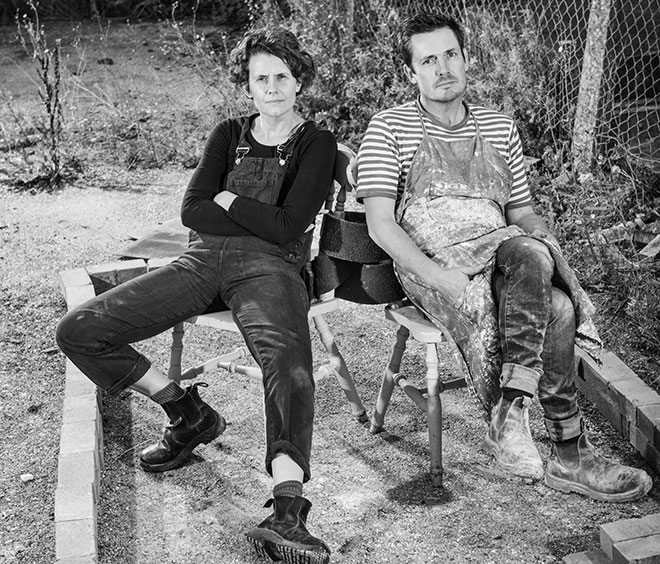
Heather Peak Morison and Ivan Winston Morison. Photo: Stephen King.
by ANNA McNAY
Heather Peak Morison (b1973, UK) and Ivan Winston Morison (b1974, Turkey) have been working together for the past 15 years. Their collaborative practice incorporates aspects of art, sculpture, architecture and performance. They are co-directors of Studio Morison, an artist-led creative practice, and their blueprint for happiness.
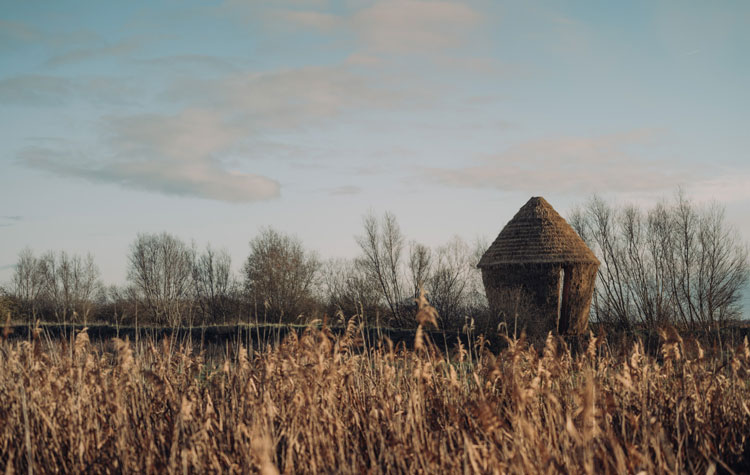
Studio Morison. MOTHER..., 2020. Commissioned by Wysing Arts Centre, and supported by Arts Council England and the National Trust. Photo: Charles Emerson, 2020.
Studio Morison was selected last year as one of the artist practices to be commissioned by Wysing Arts Centre in Cambridgeshire as part of the three-year, region-wide arts commissioning programme New Geographies, funded by the national lottery through Arts Council England, which aims to bring contemporary art to unexpected places in the east of England. Their resulting work, MOTHER …, situated on Wicken Fen, is an interpretation of a traditional fenland hayrick, and offers a space for visitors to sit and shelter and be with nature. The work also engages with the connections between the natural world and our mental health. A series of four events, furthering this connection, has, in part, been postponed due to Covid-19.
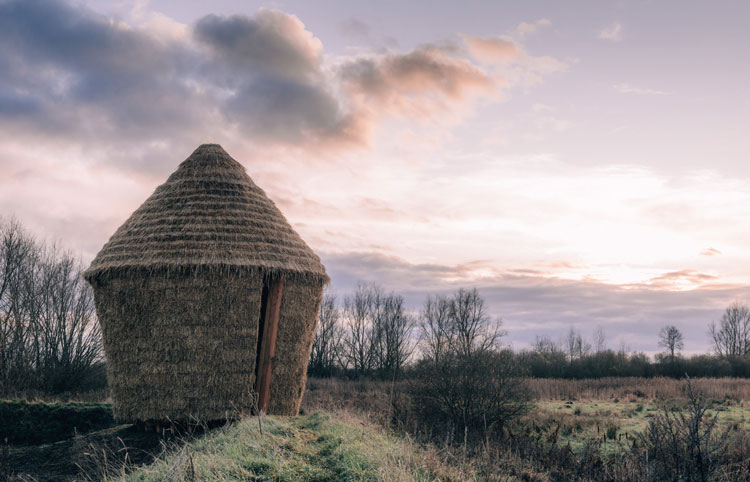
Studio Morison. MOTHER..., 2020. Commissioned by Wysing Arts Centre, and supported by Arts Council England and the National Trust. Photo: Charles Emerson, 2020.
Studio International spoke to Heather and Ivan from Studio Morison, while under lockdown, about the ideas behind MOTHER … and the artists’ wider practice.
Anna McNay: MOTHER … was commissioned by Wysing Arts Centre as part of the three-year, region-wide arts commissioning programme New Geographies, funded by the national lottery through Arts Council England, which aims to bring contemporary art to unexpected places in the east of England. Locations were nominated by members of the public and then an open call was put out to artists to submit proposals. Tell me what appealed to you about Wicken Fen, the National Trust nature reserve where MOTHER … is sited. How immediate was your idea of what to propose?
Heather Peak Morison: It was very immediate for me that I wanted to work in the Fens or the Wash. I have always been drawn to the flat lands and I read Richard Mabey’s book, Nature Cure [in which he charts his gradual recovery from depression], when I was also suffering from depression (postnatal at that point) and knew that you had to work harder to see the Fens, but, if you did, it was glorious and magical. The work of really seeing and being present, which is what the fen asks of you, is also the way to gently draw out of depression. I liked the tension between agriculture and rewilding and wanted to make a work that stayed with that trouble. We cycled all over the Fens and took boats out: it was sometimes glorious and sometimes dismal.
AMC: Do you have any familial link to the Fenland region?
HPM: I do have history and links as my father’s family all came from East Anglia and were farmers growing flowers and vegetables. When we would visit, we would often stay in small bungalows owned by aunts and uncles surrounded by leylandii trees. It was boring and everything smelled of cabbages. My great-grandfather’s farm went bankrupt, and I think he then committed suicide in one of the farm buildings, but this is only something I picked up from overhearing adults talking, so the visits were often shrouded in a sense of something seen as terribly shameful but unspoken. I can remember being shown land that my grandfather did not own any more. One aunt had a bed and breakfast on Skegness seafront, so we would stay there out of season and then paddle in the Wash, terrified of the quicksand and sheltering from the bracing wind. She would cook huge breakfasts for us all and then kick us out until 4pm. I think this was quite normal for a 1970s holiday.
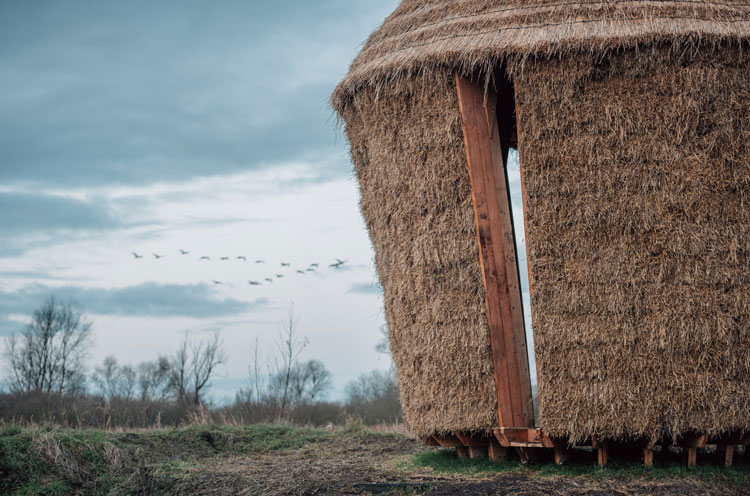
Studio Morison. MOTHER..., 2020. Commissioned by Wysing Arts Centre, and supported by Arts Council England and the National Trust. Photo: Charles Emerson, 2020.
AMc: MOTHER …, in her form, is an interpretation of the traditional fenland hayricks, which used to be a familiar feature of the landscape. The walls and roof are made from local straw, and the thatching was done in the traditional style by a master thatcher, whose first job as an apprentice was to thatch a hayrick on this very site. That’s a wonderful link. How did you come across this thatcher? And how involved was he in helping you with the architectural planning of the pavilion?
Ivan Winston Morison: I spent some time studying the thatch of the region, enquiring who had done the work, when something out of the ordinary, or of particular merit, caught my attention. Thatching in that region is, in the main, dominated by a couple of thatching dynasties, and I met and spent time with those families, looking at the long-stem straw fields they grow as materials for their work and discussing how we might go about this project. In the end, this project was too much out of the ordinary for them, since, although what you are seeing is something akin to a traditional hayrick, the technical reality is more complex. Fortunately for me, I was also in touch with Jeff, the thatcher we went on to work with, who is, you could say, an established outsider in that world. Jeff, whose first job was indeed on this site, had previously lived in the Netherlands and was able to draw on his knowledge of the traditionally thatched Dutch windmills, where vertical and sloping walls are also thatched in addition to the roof, to work with us to find a methodology to realise MOTHER … in a manner that would do it justice. His advice was invaluable.
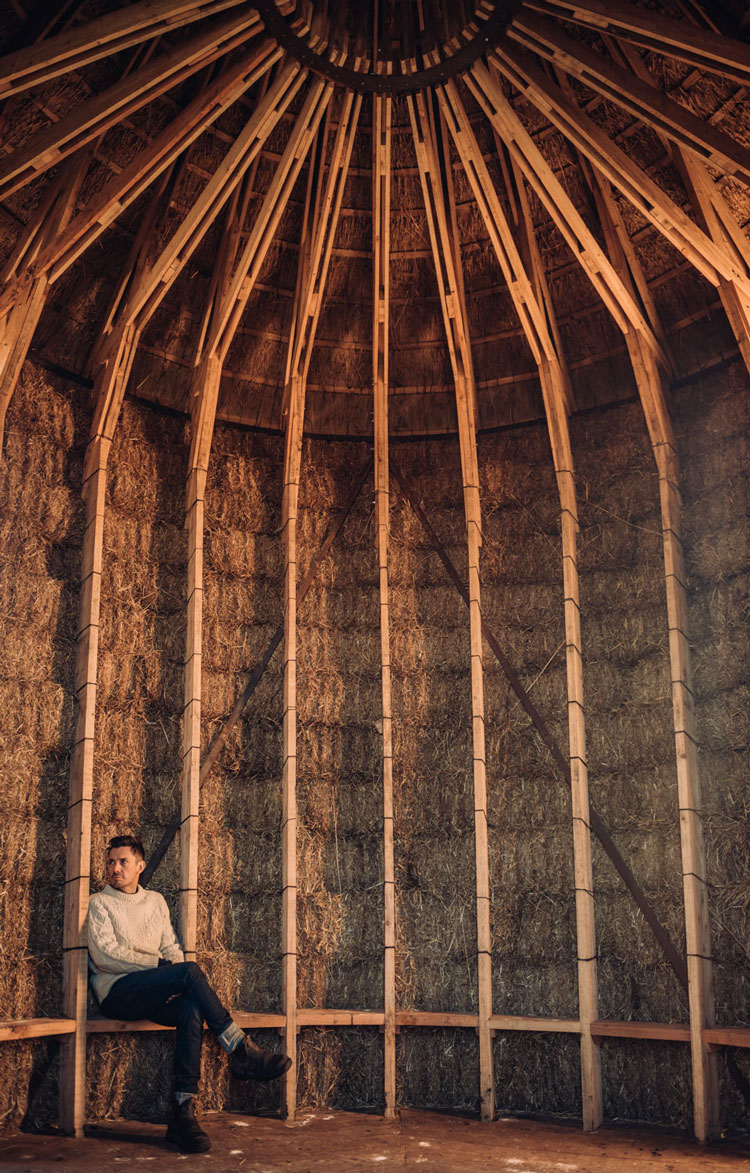
Studio Morison. MOTHER..., 2020. Commissioned by Wysing Arts Centre, and supported by Arts Council England and the National Trust. Photo: Charles Emerson, 2020.
AMc: The timber used in the framing was felled from your own forest and milled at your workshops. Where are you based that you are able to have your own forest? Do you work a lot with timber?
HPM: We are based in Herefordshire and Gwynedd, and we have worked with our woodland for the past 20 years, gradually replanting as we fell trees for commissions.
IWM: Our work with timber came after the fact of owning the forest. Conceptually, the forest sits at the heart of our practice; it is both inspiration and record. Each year we travel to gather new species to replant felled areas, and, during those journeys, we have experiences that form the basis of our practice. When the site and conditions are appropriate, we use timber from the forest to build new artworks (but this is certainly not all our works). We plant the gathered new specimens in their place. In time, these grow to become markers of this chain of experiences and transformational processes.
AMc: You’ve already mentioned that MOTHER … engages with the connections between the natural world and our mental health and is, in part, inspired by the writer Richard Mabey’s book Nature Cure, in which he recovers from severe depression through walking, watching and writing about the eastern region’s unexplored landscapes. How is this captured in the work? And how does the work speak to visitors’ mental health?
HPM: I have depression. I am well at the moment, but I know that, when I am ill, being outside and having somewhere to shelter and sit is very useful. MOTHER … means to be soothing and restful, but also acknowledges the anger, frustration and sheer terror that can be the mind. You cannot get away from your head. MOTHER … is like another head to step inside for a short while, with her own space, smell, form and light. She is meant to be strong, wise and compassionate, which is what I need when I am poorly.
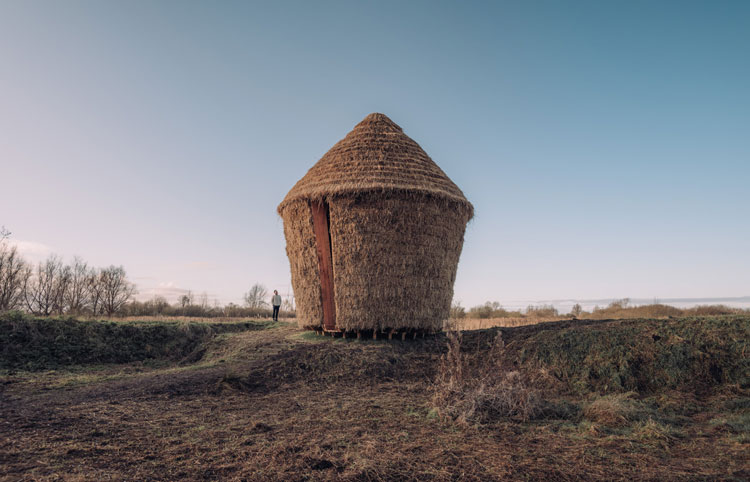
Studio Morison. MOTHER..., 2020. Commissioned by Wysing Arts Centre, and supported by Arts Council England and the National Trust. Photo: Charles Emerson, 2020.
AMc: Beyond the architectural and mental-health references, what else do you intend MOTHER … to offer visitors as an artwork? For example, in terms of an aesthetic or living experience?
IWM: I am not an architect, nor do I have any professional expertise in mental-health therapies, but what I am is an artist, and principally a sculptor, so this is where I begin, this is the lens through which I create work, and embodied within that is a set of formal concerns and principles that I use to judge the work. Therefore, as a sculpture, I would ask whether MOTHER … reframes how we see the world. Is our experience of her more than analytical – does she move us, does her form challenge, surprise and please us, is she unique?
AMc: Tell me about the title of the work – in particular the ellipsis. Why is that there? And what does the loaded concept “mother” evoke for you and how was it relevant to the work?
IWM: Titles are the best and worst of things. At best, they can help frame and introduce the viewer to possible new layers of reading the work; at worst, they can be employed as a shortcut to profoundness. With the title MOTHER …, there is a degree of animism at play – it’s important that people connect to this arrangement of wood and straw on a more emotional and personal level. The title helps with this. It also helps express the duality of feelings the work and the subject evoke – those of hope, cure, comfort and nature, against those of grief, hatred, terror and disconnection. The ellipsis opens it up further, allowing us to fill in all the partner words that might be added, offering drastically different readings of the work – from the utopian sci-fi exploration suggested by “mother ship”, to the devastating angst we may feel when faced by modern life, suggested by “Motherfucker”.
AMc: You had a programme of performance, spoken-word and musical events, again relating back to mental health, scheduled to run in the pavilion (now on pause due to Covid-19, but hopefully to be rescheduled afterwards), titled MOTHER-SHIP, MOTHER-EARTH, MOTHER-LOVE and MOTHER-LAND. These events involve collaborations with other artists. Can you tell me a little about each one?
IWM: We wanted to put in place a light programme that helped explore the breadth of readings that MOTHER … might offer – really just opening up the space for people to have their own experiences. MOTHER-SHIP spoke of the idea of the work as a vessel of travel and transformation; MOTHER-EARTH talks of our relationship to nature and our stewardship of the land in light of the work at the fen, other rewilding projects, and the area’s intensive agriculture; MOTHER-LOVE speaks to us of modern life and the (dis-)connections between one another that follow from that (this one also involves a lot of eels); and MOTHER-LAND speaks of our connection to place and to people, from both a micro- and a macro-perspective.
MOTHER-SHIP by Studio Morison, 2020. A lockdown presentation at the artists’ studio of an improvised performance piece by musician Jacken Elsworth and dancer Sam Amos inspired by the artwork MOTHER.
AMc: Is this typical for your practice, that you incorporate collaborations and live/performative events?
HPM: Yes, and we are doing this more and more of late. It is utterly thrilling and means that ideas get further composted and shared.
IWM: Collaboration has always been fundamental to what we do. Early in our practice that was through sharing time with people doing what they found important in their lives (the Still Lives radio series on Resonance FM), in time this became more a process of understanding making and crafts processes and building new works that would allow us to enter into those processes with people. Now, it’s a more a curatorial creative collaborative process, where we prepare the ground and ask to be surprised.
AMc: You have spoken of MOTHER-EARTH as an idea of connecting with the natural world, its supporting qualities, but also our own responsibilities and personal connections to it. This seems especially relevant right now – although, obviously, it was planned far in advance of anyone knowing there would be a global pandemic. How do you see our relationship to the natural world and what do you think we need to learn most from this global crisis?
HPM: I think that we need to live in symbiosis with nature and I turn to Donna Haraway and Rebecca Solnit for guidance. In Staying with the Trouble: Making Kin in the Chthulucene, Haraway writes: “It matters what matters we use to think other matters with; it matters what stories we tell to tell other stories with; it matters what knots knot knots, what thoughts think thoughts, what descriptions describe descriptions, what ties tie ties. It matters what stories make worlds, what worlds make stories.”
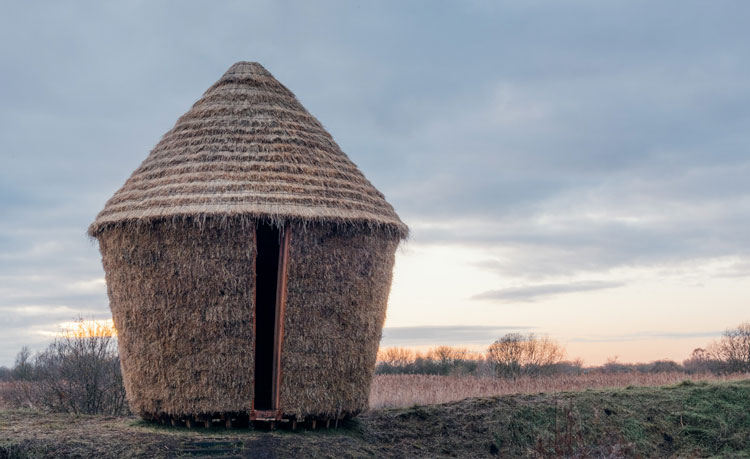
Studio Morison. MOTHER..., 2020. Commissioned by Wysing Arts Centre, and supported by Arts Council England and the National Trust. Photo: Charles Emerson, 2020.
IWM: Our work has always fundamentally been about change, an idea that’s very popular now, and our strategy has always been one of collective psychological preparedness. This is where the social comes into our practice – if we build strong, empowered networks of communities that have experience of prevailing and pulling off seemingly impossible tasks and that have found a way to exchange ideas and points of view in an open and constructive manner, then we have built a resilience to whatever may come. What has happened recently has shown how important this is and a gaping lack of this psychological preparedness, but, within this process itself, has begun to build these communities and a future resilience.
AMc: MOTHER … remains accessible to the public during lockdown. What does she have to offer visitors, especially during this time? Has the current situation amplified the message and purpose you intended, or has it rewritten it at all?
IWM: MOTHER … was made to heal us now, to prepare us for the future. We are now in that future, and she can help us still.
HPM: I think about her at night, she still soothes. The owls still live there, and some people visit.
AMc: You’ve been working together for the past 15 years and co-direct Studio Morison. Does this studio just comprise the two of you, or is it a much larger entity?
IWM: It is a vast entity, a complex web of relationships. It is about those interconnected lives and finding ways in which we can sustain them.
HPM: Yes, there are a lot of people involved all over the place.
AMc: What are your individual backgrounds and training? Did you come to art from architecture, or vice versa?
IWM: We are artists.
HPM: I am also qualified to run a fish and chip shop, just in case.
AMc: How did you meet and begin working together in the first instance?
IWM: We met at art school. We began working together some time later with the realisation that, to do the work and its audience justice, it was an all-or-nothing choice. We had to be artist first and foremost without distraction – we entered into that agreement together in total seriousness of commitment.
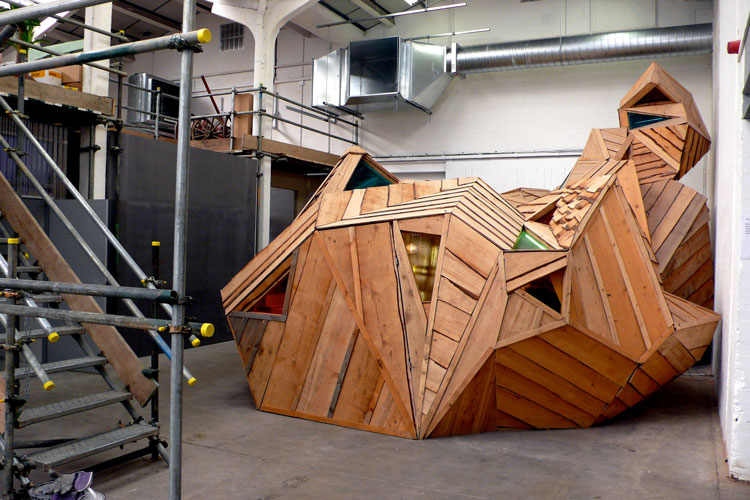
Studio Morison. Pleasure Island, Eastside Project Birmingham, 2008-13. Photo: Ivan Morison.
HPM: I did not want to be an artist. I thought it a silly idea.
AMc: You represented Wales at the 52nd Venice Biennale in 2007. You mentioned you are based partly in Gwynedd. Do you have further Welsh connections?
IWM: We lived in Wales, my family on my mother’s side are Welsh. We still have a base in Gwynedd. For the biennale we made a work that was sited in Venice and Wales.
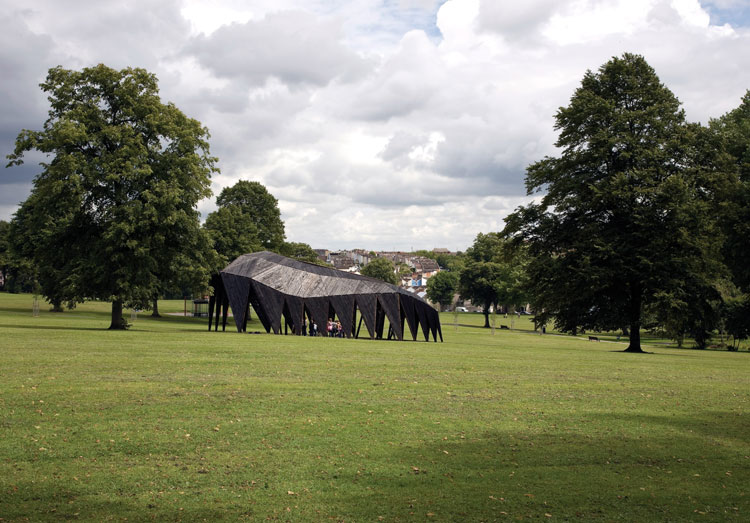
Studio Morison. Black Cloud, Victoria Park Bristol, 2015. Photo: Wig Worland.
AMc: Is your work always site specific, and does a site-specific work ever get shown again elsewhere – for example, if it is acquired by a museum or collection? If so, how does this change its original meaning? Do you have any examples you can refer to?
IWM: Yes, it is always site-specific. It sometimes also moves to new locations, but only in the right circumstances, and always with additions, modifications, or in combination with other works. For example, Black Cloud, originally made for Victoria Park in Bristol, moved on to the Hepworth Wakefield, with the addition of a huge, burnt-black, timber plaza beneath, before later moving to Eastside Projects in Birmingham, where it was combined with another work, Pleasure Island, to become Black Pleasure, incorporating the new element of a bar and kitchen, to be used for meetings and performance. After its life there, it retuned to our yard, where it has since been reworked and combined with the rug work The Raspberry Ripple Cuddle Puddle to become a new room that sits within our home and now provides a very strange bedroom for one of our children.
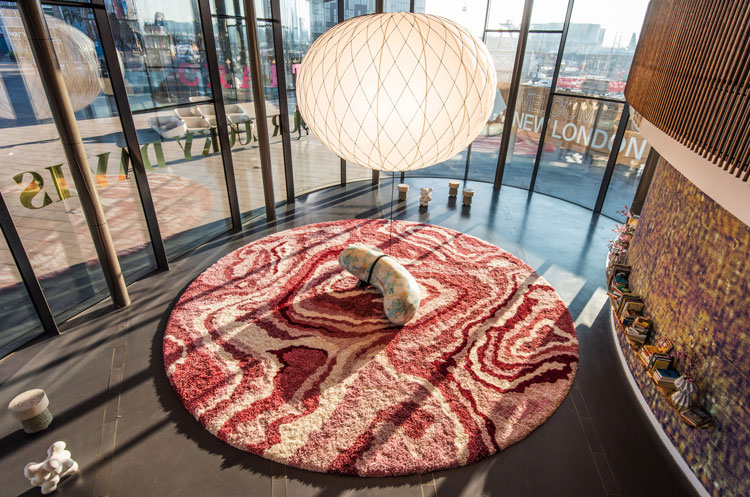
Studio Morison. The Raspberry Ripple Cuddle Puddle, part of The Mouse and His Child installation, NOW Gallery, London, 2019. Photo: Charles Emerson.
AMc: What will happen to MOTHER … once she is taken down from her current location?
IWM: We never know. It’s best that way.
HPM: The works always find the next place themselves.
AMc: It seems that the question of bringing different practices together, and questioning the boundaries of visual art and other creative art forms, is key to what you do. For example, you led a thematic residency, Blueprint for Happiness, at the Banff Centre, Canada, in the summer of 2015, explicitly engaging in the dialogue around redefining the limitations of where and how it is possible for artists to work. Can you say a little about what this involved, and, again, how it related to your wider practice and the core concepts underpinning your practice?
HPM: This involved a dozen architects, curators, artists and dancers coming together in the wonderful Banff Centre, where Helen Chadwick made piss flowers in the snow. We taught some practical stuff about how to get things done and trying to make a living, and then we did a group work together, in a very short period, under great pressure, with each person in their area of expertise and managing and recognising the tension and spark when they overlap.
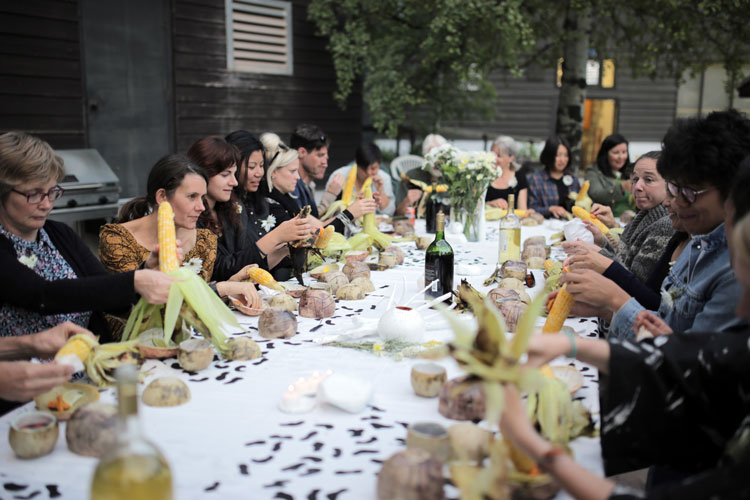
Studio Morison. Impossible Rainbow dinner, Blueprint for Happiness, Banff, 2015.
The artists spent a lot of time in the bar discussing things, and I spent a lot of time researching contemporary dance in the library and talking with the choreographer Crystal Pite and her team, as they were making the work Betroffenheit there at the time. So, the practice is a big mixture and compost of what we can make, who we can work with, what we do with process, tension, failure, production, traction, compassion, instinct, aesthetic and hard work leading the way.
AMc: On your website, you state: “Studio Morison is concerned with creating a blueprint for happiness.” How do you define happiness? And what would be in the blueprint? How do you – or does one – attain happiness?
IWM: The studio itself is the model for achieving happiness within our own lives. It provides everything we require for a happy life – a balance between a general fulfilment of dreams and the quiet lurking terror of failure. We use this as a model which we expand out into the wider world.
HPM: We are managing to hold on. That is enough for happiness – staying with it.
AMc: Do you see your practice as political? A form of activism, even?
IWM: I see our job as to activate discussion and open pathways previously overlooked. So not political, more operational. But we get to choose which pathways and the subjects of discussion. So political.
HPM: Yes, but we are stealthy. We have more power that way.
AMc: On your website, you distinguish between what you hope to achieve on a human level versus on a societal level. How can you draw the human out of society? Do you believe more in the individual than in community? If so, how does this square with the collaborative nature of your work?
IWM: We each face our own horrors that shape our individual lives. We work with this to suggest a personal resilience each of us can call upon. This is different from our responsibilities and our part in wider society where we operate as a murmuration, moving as one body, but where any individual can still shape the path of the whole when a degree of consensus is formed.
HPM: As to the collaborative nature of our work, it is the same, we must work to be strong in ourselves and our thoughts, in order that we can contribute meaningfully to the whole.
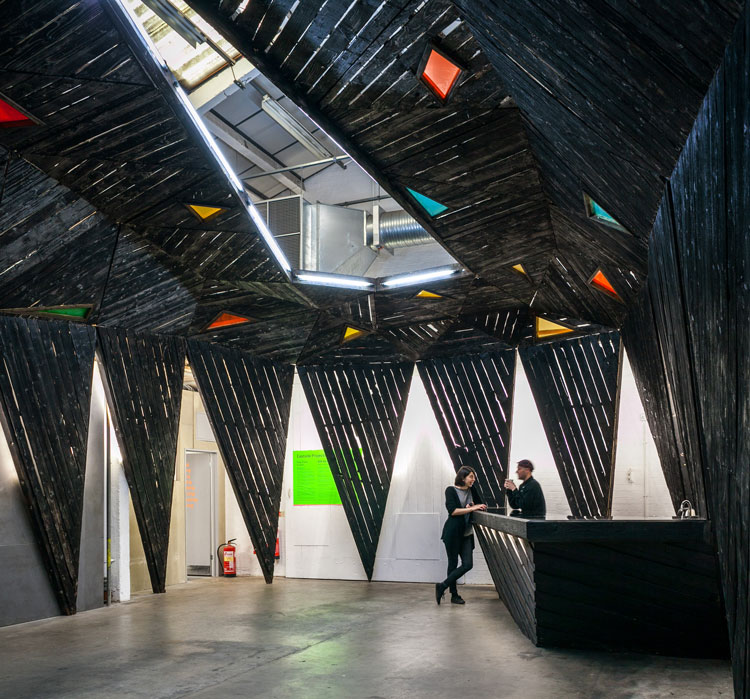
Studio Morison. Black Pleasure, Eastside Projects, Birmingham, 2013. Photo: Ashley Carr.
AMc: Do your artworks exist in and of themselves, or do they always require people to complete them?
IWM: People.
HPM: People, yes.
AMc: What are you up to during lockdown? Are you able to continue working? Have you got a new project lined up already for after MOTHER … is over?
IWM: Many projects, much more human-level work, one big workshop build for later in the summer that we are able to continue with, some interestingly adapted projects which open new challenges and possibilities for the future.
HPM: Holding on to existing social sculptures and tentatively forming some new ones in this new world. Doing a lot of composting with people and talking about stuff and things rather than it.
• MOTHER … is at Wicken Fen, Cambridgeshire, until further notice. For further information on the new dates for the accompanying events, see newgeographies.uk/event/studio-morison.